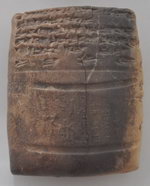| blockwalk.org |
from.. http://www.livius.org/mi-mn/mitanni/mitanni.html
|
|||||||||||||
itanni |
|||||||||||||
|
|
Mitanni or
Mittanni: ancient kingdom in
modern Kurdistan, northern Iraq, and Syria, attested in the third
quarter of the second milennium BCE.
If ever the cliché "forgotten empire" could be applied to an ancient state, it must be Mitanni, which is, in fact, hardly more than a name and a handful of archaeological and linguistic hypotheses. Yet, we can combine several types of information, and where they confirm each other, we can probably be confident that we are not extremely far from the historical truth. It is almost certain that the heartland of Mitanni was situated somewhere along the upper Khabur in Mesopotamia, the country between Euphrates and Tigris. The capital of Mitanni, Waššukanni, and the important cities Kahat and Taide have not yet been identified, but it is reasonably certain that they must be sought somewhere in the southeast of Turkey or east of modern Syria. At the time of the decline of the Old-Babylonian Empire, the kings of Mitanni were able to expand their realms. To some extent, the two processes must have been related: Babylonian loss of control offered an opportunity to Mitanni, the rise of Mitanni weakened Babylonia, and as a result, the Hittite king Mursili I could proceed along the Euphrates and sack Babylon, probably in 1595 BCE. The details are obscure, but the result is not: in c.1500, king Parrattarna of Mitanni was an important ruler, sufficiently powerful to control the city of Aleppo in Syria, halfway between the Euphrates and the Mediterranean. Mitanni was not the only imperial power interested in Syria. The Egyptian king Thutmose III (1479-1425) often campaigned in this area, and during his eighth campaign, the pharaoh defeated the ruler of Mitanni and his local allies. The Egyptians reached the Euphrates, built ships, and ravaged the banks all the way from Karchemiš to Emar, towns that belonged to Mitanni. However, the Egyptians, who did succeed in capturing many Mediterranean ports, were ultimately unable to gain control of the Syrian interior. Eventually, friendly relations were established by pharaoh Tuthmose IV (1401-1391) and Artatama I of Mitanni. In Syria, the expansion of Mitanni's power was checked, but in the east, the kingdom continued to grow. King Sauštatar (c.1415) reduced Assyria and humiliated its inhabitants by sending the doors of the famous temple of Aššur to Waššukanni. By the end of the fifteenth century, southeastern Turkey, northeastern Syria, northern Iraq, and northwestern Iran -in other words: more or less the area that is now populated by the Kurds- was under direct or indirect control of the Mitannian king. This territory is also the area where people spoke Hurrian, a language that is not related to the Semitic and Indo-European languages. Although not every subject of the king of Mitanni spoke Hurrian, and not everyone who spoke Hurrian was a Mitannian, the two are connected and it is no coincidence that after 1400, when Egyptian power in Syria collapsed and Mitanni could continue its western expansion, we also find a rapid rise of Hurrian in Kizzuwadna (Cilicia). Mitanni's cultural influence was also felt in neighboring states like the Hittite Empire, where several kings have Hurrian names and Hurrian gods were worshipped (e.g., at Yazilikaya). |
||||||||||||
 Cuneiform letter from Tell Brak. It displays the seal of a ruler of Nuzi named Saustatar, who writes that this seal is, from now on, being used by king Tušratta of Mitanni. Museum of Deir es-Zor (Syria). |
It has been argued that Mitanni was in fact a federation of Hurrian-speaking states, united by a cavalry elite that spoke an Indo-Iranian language. Three texts are important.
Although the connection between the Indo-Iranian language and chariotry appears to be reasonably certain, it remains to be proved that the people speaking Indo-Iranian belonged to a warrior elite. They can also have been trainers or grooms. On the other hand, it is remarkable that in the palaces of the Hurrian-speaking elite, we find Habur ceramics, which closely resembles pottery from Hyrcania in the east. The nature of Mitannian society still remains a puzzle. We are better informed about its international relations. The Egyptian kings Tuthmose IV and Amenhotep III (1391-1353) married to Mitannian princesses, and when the last-mentioned pharaoh was ill, the statue of the Mitannian goddess Šaušga was sent to cure him. All this can be derived from the Amarna Letters, an archive of diplomatic correspondence from Egypt. After the mid-fourteenth century, Mitanni was plagued by a dynastic crisis. As usual, we can not understand the details, but it is more or less clear that the young king Tušratta was not universally recognized and lost control of Assyria at the beginning of his reign. In the northeast, a man named Artatama II seems to have created a kingdom of his own, and Mitanni now was an easy target for the Hittites. Although Tušratta was able to defeat the Hittite king Suppiluliuma (1344-1322), on a second occasion, Waššukanni was captured and sacked. Immediately after, the Hittites installed new rulers in the Syrian towns that had belonged to Mitanni. Tušratta was killed and his son Shattiwaza became a vassal of Suppiluliuma. At the same time, Artatama was becoming a puppet king of a reborn Assyria, led by king Aššur-Uballit I (1364-1328). The Egyptian kings Amenhotep IV (Echnaton; 1353-1336) and Tutankhamun (1336-1327) who might have saved Mitanni, were too occupied with their own affairs to send help. Mitanni was never restored. The future belonged to the Hittites and Egyptians, and -later- to Assyria. We would like to know more about Mitanni, and we probably will once Waššukanni has been identified and excavated. |
||||||||||||